
The Offshore and Specialised Ships market
in 2000 |
|
|
| |
|
At the beginning of 2000, crude oil prices broke
through the barrier of $25 per barrel and hit a peak of $36 per barrel
in September, close to the highs experienced at the time of the Gulf
War. Since then there has been a drop back to $26 per barrel in
December. Producers and experts alike are basing their medium term
forecasts on a price around $25 per barrel, and at this level it should
encourage a substantial increase in exploration budgets and offshore
production (for reference, the estimate for last year was $12-15 per
barrel).
We leave it to the oil specialists to give an
explanation for the real reasons of this sudden surge in prices, but we
have nonetheless taken note that the current projections on proven crude
oil reserves are not as important as the experts have led us to believe.
Meanwhile, specialised geophysicists are intensifying
their efforts with the help of 3D techniques and have perfected computer
software which allows enormous progress in interpreting seismic tests
and which assists the development of new deep offshore fields.
It is reasonable to expect that exploration budgets
will be increased and that they will return to a level above $100
billion in 2001, with a particular emphasis being directed towards the
deep seabed. These new offshore drillings, require not only more
important and sophisticated techniques for drilling and producing, but
also the need of bigger, more numerous and more powerful workships and
transport ships.
|
| Support vessels: Platform supply vessels (PSV) and Anchor
handling tug supplies (AHTS) |

|
|
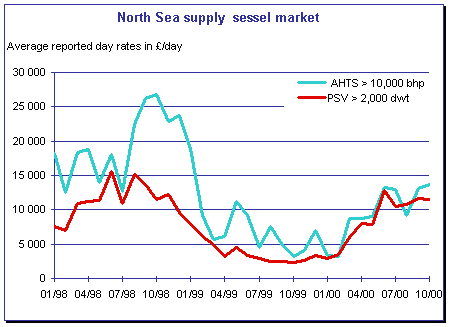
Players in this market were pessimistic in January
2000 but the important drop in freight rates at the beginning of the
year was partly compensated by the increased chartering of supply
vessels specialised in pre and post laying of optical fibre cables.
The market had to wait until the autumn in order to
see a significant improvement in freight rates, but it then only took a
month before the levels of different categories of supply ships
increased. Against expectations, it was the prices in the Gulf of Guinea
which were the signal for this general firming up.
A greater number in the movements of supply ships and
the fact that several PSV were taken out of the market and used for
cable laying, as well as the dispatch of some units towards the deep
offshore African sites in the spring of 2000, upset the North Sea spot
market and charter rates started to take off. The market hit a high in
the summer with spot levels touching '20,000 per day.
Given the context described above, this has produced
a number of newbuildings of PSV and AHTS on behalf of Norwegian and
American owners. In contrast to the wave of newbuildings in 1996-98,
orders of some 80 units cover the whole spectrum of the fleet. In
particular there have been a number of medium-size vessels in the UT
719/755 class of 4-5,000 kW.
This revival in the offshore markets and the
prospects of a drop in subsidies to European and especially Norwegian
shipyards has largely contributed to an unprecedented surge in renewing
and modernising of the fleet of the main players (Gulf Offshore,
Tidewater, Surf, Dof, Solstad, Farstad, Swire Pacific, Sealion).
In particular we have observed a policy of aggressive
expansion from the world's largest owner of supply vessels (Tidewater,
based in New Orleans with over 600 units) who purposefully kept out of
building any new vessels in recent years, has ordered a number of units
in the UT 755 class for construction in Norway. In addition the company
has bought six modern units from the Japanese Sanko for a sum of $ 160
million. Tidewater has also placed orders in the US and China for more
than 12 big-sized PSV and AHTS.
Gulf Offshore Aberdeen, a subsidiary of Gulf Mark
Offshore USA, ordered at the end of the year seven AHTS and PSV types UT
722L, UT 755, UT 755L, and UT 745 with Aker Brattvaag in Norway to
replace the Sanko ships, sold as mentioned above, that they had under
bareboat charter.
Another fact worth mentioning is the success of the
Norwegian engineering companies such as Rolls Royce Marine AS
(ex-Ulstein, ex-Vickers) and Vik Sandvik, who have managed to impose
their concepts and designs of support ships on owners and shipyards
worldwide.
Surf is continuing to develop with its local partners
its foothold in Angola and will be putting into service in 2001 two
Azimuth tugs of 65 tons bollard-pull being built with Damen, Holland, as
well as a PSV (UT 755) being built with Orskov in Denmark within their
service contract with Sonagal/TotalFinaElf. An additional UT 755 has
been placed with Orskov on speculation.
The year 2001 looks encouraging for shipowners and
owners of floating equipment designed for drilling and producing
offshore in West Africa, Brazil, and the Gulf of Mexico. It would appear
that ships which are dynamic positioning and can handle ROV operations
and underwater work will be hard to find.
|
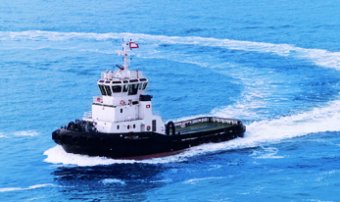 |
ABEILLE FECAMP
2 x 2,500 bhp, built by Alstom Leroux Naval - Operated by Les Abeilles Le Havre. |
|
| Drilling |
 |
|
The merger tendency has continued with the birth in
2000 of a drilling giant following the take-over of Reading and
Bates/Falcon by Transocean-Sedco. In the longer term, drilling rig
operators are expected to consolidate into four or five companies which
will represent at least 80 % of mobile units.
The turnaround in the offshore markets was felt first
in the shallow water drilling. In practice the jack-up rigs have seen
their utilisation rate climb during 2000 to levels today around 90 %.
The high levels of use gives owners hope of seeing a strong rise in the
chartering rates for 2001. We have also seen a number of speculative
orders of new jack-up rigs which have already been placed with the main
yards, Chile Offshore with FELS, Maersk Drilling with Hyundai Offshore,
and finally a 25 % share purchase by Enesco in a building unit with FELS
based on a standard design of F&G MODV.
Santa Fe made a name for itself with an ambitious
newbuilding programme comprising two new semi-submersibles and six new
jack-up rigs.
This year also saw the delivery of the last drilling
units due to be built. Generally their owners were faced with the
classic problem of the initial servicing of these new units.
The second-hand market saw a few unspectacular deals
but which underlined the basic optimism of owners and the healthy state
of their cash-flows. Pride bought two second generation
semi-submersibles, the 'Drillstar' and the 'Sedco Explorer',
both having been in the hands of American private investors, as well as
a jack-up rig ' the 'Energy Explorer IV'. Fred Olsen through its
affiliates Fred Olsen Energy and Dolphin Drilling also purchased two
second generation semi-submersibles of the Aker H-3 class which are
compatible with the original design of units in service with the Dolphin
Drilling fleet. In addition this company took a majority shareholding in
Navis Asa, a Norwegian company that controls the 'Navis Explorer' a
new drillship built by Samsung.
To the extent that there are virtually no builders of
mobile drilling rigs left in Europe, we question what will be the reply
from the three main Asian yards when all the service companies start
making commitments for newbuildings in reply to the oil companies'
tenders. This situation could also be aggravated by the current
consolidation amongst builders. On the one hand, Friede and Goldman
(USA) has become the uncontested leader in the design and construction
of drilling units, and the group Keppel-FELS has undertaken joint
ventures and take-overs in order to operate on the Brazilian and Azeri
markets, and they envisage also becoming the main shareholders in
Verolme Botlek, leader in repairs and refitting of drilling units in
Europe.
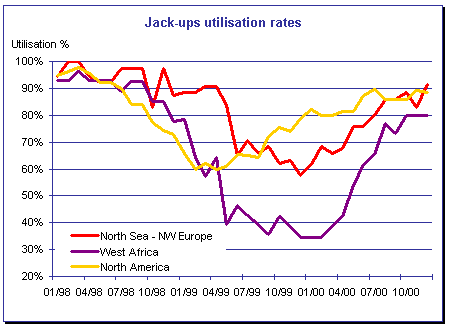
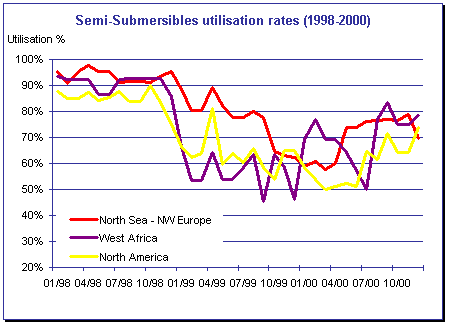
|
| Construction and underwater work |
 |
|
The year 2000 saw reduced activity in this sector as
the oil companies' investment budgets were put on hold. This
depressive mood led to a number of mergers which in turn has brought
about a wholesale reorganisation in this area of the offshore industry.
Coflexip Stena Offshore bought at the start of the
year R H Brown, Houston, and at the year's end took over Aker
Offshore, Houston, the subsea construction branch of the Aker Maritime
Group, which through their American holding will give them
a better position in the Gulf of Mexico. Coflexip then sold its share in
CAL Dive, Houston. Technip bought Stena Offshore's part in CSO, and
the Technip and Coflexip combination appears promising as the activities
of the two companies are complimentary. Bouygues Offshore and Doris are
looking to combine their efforts in the Gulf of Mexico with the setting
up of a single affiliate in Houston.
Stolt Offshore has carried through the purchase and
integration of ETPM, despite indifferent results, and we expect to see
an ambitious development on the part of this operator. We would like to
end this section by outlining the increasing use by the large underwater
companies of sub-contracting or outsourcing non-core activities to
owners such as Solstad, Farstad, Augusta, or Surf.
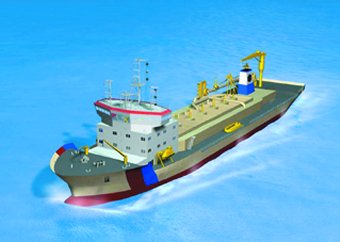 |
Artist view of dredger
to be delivered in 2002 by Izar to GIE Dragages Ports. |
|
| Floating production storage and offloading vessels (FPSO) |

|
|
Oil companies have also increased their investments
in this sector of the offshore market, linked to the production of oil
and gas. The floating production systems will be mainly located in the
future in the offshore fields in West Africa (ex-Girassol in Angola) and
Latin America (ex-Marlim Sul in Brazil), in depths of 500-1,300 metres.
The North Sea fields have been fully equipped for some time and the
American authorities prohibit the use of floating production systems in
the Gulf of Mexico waters, where they have been replaced by a system of
storage fixed to the seabed under tension and where the underwater
pipeline network is dense enough to permit connections. The MAD DOG
project being developed by BP will perhaps see the first new FSO
operational in the Gulf of Mexico.
Generally speaking, the market tends to divide into reconverted
second-hand vessels which are rented out to oil companies
(Chevron/Kuito, Exxon FPSO in West Africa) and the new FPSO looking for
long-term employment with the oil companies. These latter units are
considered as real fixed production units. In the first category, the
market is organised around specialists such as SBM, Bluewater,
Modec/Sofec, formerly suppliers of anchoring systems and who have
finished by responding to the turnkey projects of the oil companies.
In the second category, the size of the projects and the sums
involved together with the need of risk controls, calls for a direct
involvement from the oil companies and the need of building contracts
such as EPCI with the ad hoc grouping amongst the well established
contractors such as Halliburton, Brown and Root, ABB, Technip, Bos,
Aker, and Saipem.
The year 2001 risks being crucial in the area of new, big-sized
FPSO/FSO as Exxon (Kizomba), Texaco (Agbami), TFE (Dalia), BP (US Gulf
and Angola) and Chevron have either put out or will shortly be putting
out to tender for the building and the installing of this type of units,
mainly for West Africa and in particular Angola and Nigeria.
We question the ability of the large Asian yards to be able to meet
the needs of the general contractors and fulfil the technical
specifications of the oil companies. Apart from one European yard, the
choice is restricted to the big Japanese or Korean yards. The latter are
almost fully booked with the surge in newbuildings of all types of
vessels and their schedules of delivery dates cannot easily be
integrated into the timetables of the oil companies.
In an attempt to get around the problem of tight capacity, the
project Elf Amenan in Nigeria envisages the initial construction of a
FSO of 2.4 million barrels in the form of units built onshore which will
then be assembled on a barge or in a drydock.
|
| Cable laying vessels |
 |
The year 2000 saw
an abundance of newbuildings and refitting of cable vessels specialising
in the laying and maintenance of fibre optics for the following reasons
:
- Firstly due to the gigantic leap in worldwide transmissions linked
to the Internet.
- A multitude of telecommunication operators following deregulation
and consequently an equal number of companies owning underwater
fibre optic cables.
- The answers provided by the research and development departments
of industrial manufacturers, principally Tyco and Alcatel, which
allow the building and operating of numeric systems with ever bigger
and more reliable transmitting capacities.
- The tenders of established and start-up operators, linking the
building of systems to the laying and complimentary work upstream
and downstream, but also the maintenance work for periods of several
years (up to 10) on a turnkey basis.
- Operators insisting on highly reliable connections and a more
careful and deeper burying of cables in the seabed 2-3 metres deep,
and at depths up to 1,500 metres. The laying should be at a speed
not exceeding one knot, which significantly increases the
installation time and thus leads to an increase in the number of
vessels to carry out such work.
- Finally the ageing of the world cable laying fleet and the high
freight levels due to the scarcity of vessels.
The thirty cable vessels for laying and maintenance under order or
under conversion will enter into service for the most, part between
mid-2001 and mid-2002. Amongst the units are those ordered by French
companies Alda Marine (j/v Louis Dreyfus/ASN and FT Marine). Several
other vessels have been ordered by the traditional cable operators such
as Tycom, USA and Global Marine, but a considerable number have also
been taken up as speculation by new owners to this market such as AP
Moller, Danemark, Solstad, Norway and Dockwise. These units have found
medium and long term employment with ASN, Tycom, and Global Crossing.
The need for large laying vessels should be covered by the delivery
of ships currently being built, while future orders or refits of cable
vessels should concern mainly the maintenance ships. The latter with a
capacity of some 2,000 tons of cable will rely on dynamic positioning
navigation and will see their speeds and length improved to enable them
to repair any defective cables quickly.
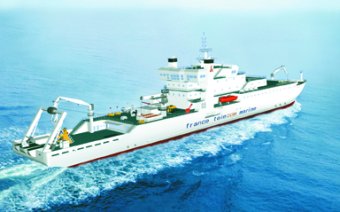 |
Artist view of a cableship
to be delivered end 2001 by Hanjin - Owned by FT Marine |
|
|

Overall the year 2001 appears to be
propitious for the whole offshore industry. To conclude we should like
to quote an extract from the book "Underwater cables" written
in 1903 by Alfred Gay : "the underwater networks, 50 years after
the creation of the first amongst them, now girds the entire globe. And
the final word has not been said. To the existing links, each year
further links are added."
|
Shipping and Shipbuilding Markets in 2000
I N D E X
|